| Kronosaurus | |
|---|---|
 | |
| Proposed neotype skull, QM F18827 | |
| Scientific classification | |
| Domain: | Eukaryota |
| Kingdom: | Animalia |
| Phylum: | Chordata |
| Class: | Reptilia |
| Superorder: | †Sauropterygia |
| Order: | †Plesiosauria |
| Family: | †Pliosauridae |
| Subfamily: | †Brachaucheninae |
| Genus: | †Kronosaurus Longman, 1924 |
| Type species | |
| †Kronosaurus queenslandicus | |
| Synonyms | |
| |
Kronosaurus (/ˌkrɒnoʊˈsɔːrəs/ KRON-oh-SOR-əs; meaning "lizard of Kronos") is an extinct genus of short-necked pliosaurs that lived during the Early Cretaceous period (Aptian to Late Albian) in what is now Australia. It is a monotypic genus with one species K. queenslandicus, described in 1924 from the Toolebuc Formation in Queensland, Australia. With traditionally attributed fossils indicating a total length of up to 10 meters (33 ft), Kronosaurus may have been among the largest pliosaurs.
The status of this genus is contentious due to the fragmentary nature of the holotype, which is a non-diagnostic partial mandibular symphysis. This led to a 2021 study to reduce Kronosaurus to a dubious taxon and reassign all other fossils previously assigned to it, including several partial skeletons, to a new genus. The move was heavily criticized as introducing taxonomic instability by supplanting an iconic name when a preferred solution would have been to petition the ICZN to designate a diagnostic neotype. Although a petition has yet to be submitted, several specimens have already been proposed as neotypes, and subsequent studies have maintained the use of Kronosaurus on this account.
Kronosaurus inhabited the Eromanga Sea, an inland sea that covered parts of central and eastern Australia during the Early Cretaceous and reached rather cold temperatures. It was probably an apex predator that preyed on other marine reptiles. Remains of plesiosaurs and turtles have been found as stomach contents of traditional specimens from the Toolebuc Formation.
Research history
Discovery and naming

The first known specimen of Kronosaurus was discovered in 1899 in the town of Hughenden, Queensland, Australia, by Andrew Crombie, and consists of a partial mandibular symphysis bearing six conical teeth. After this discovery, Crombie donated the fossil to the Queensland Museum and was cataloged under the code name QM F1609. 25 years later, in 1924, Albert Heber Longman published a paper that identified the specimen as the holotype of a new genus and species of a pliosaur, which he named Kronosaurus queenslandicus.[2] The etymology of the binomial name comes from the Ancient Greek Κρόνος (Krónos, "Kronos"), a Titan from the Greek mythology, and σαῦρος (saûros, "lizard"), to literally give "lizard of Kronos", in reference to the imposing size and the possible ferocity of the animal. The specific epithet queenslandicus is named after the Queensland, the Australian territory from which the holotype specimen was discovered.[3] Additional material from Kronosaurus, including a partial skull, was discovered in 1929, in the same location as the original discovery made by Crombie.[4]
Harvard's completed skeleton

In 1931 the Harvard Museum of Comparative Zoology (MCZ) sent an expedition to Australia for the dual purpose of procuring specimens – the museum being "weak in Australian animals and...desires[ing] to complete its series" – and to engage in "the study of the animals of the region when alive."[5] The Harvard Australian Expedition (1931–1932), as it became known, was a six-man venture led by Harvard Professor William Morton Wheeler, with the others being Dr. P. Jackson Darlington Jr. (a renowned coleopterist),[6][7] Dr. Glover Morrill Allen and his student Ralph Nicholson Ellis, medical officer Dr. Ira M. Dixon, and William E. Schevill (a graduate-student in his twenties and Associate Curator of Invertebrate Palaeontology).[5][8][9] MCZ director Thomas Barbour said at the time "We shall hope for specimens' of the kangaroo, the wombat, the Tasmanian devil and Tasmanian wolf," and the mission was a success with over 300 mammal and thousands of insect specimens returning to the United States.[6][8] Yet Mr. Schevill, the team's fossil enthusiast, remained in Australia after the others had departed and, in the winter of 1932, was told by the rancher R.W.H. Thomas of rocks with something "odd" poking out of them on his property near Hughenden.[4][10][8][11] The rocks were limestone nodules containing the most complete skeleton of Kronosaurus ever discovered.[4][12][13] After dynamiting the nodules out of the ground (and into smaller pieces weighing approximately four tons[14][15]) with the aid of a British migrant trained in the use of explosives,[16] William Schevill had the fossils shipped back to Harvard for examination and preparation. The skull—which matched the holotype jaw fragment of K. queenslandicus—was prepared right away, but time and budget constraints put off restoration of the nearly complete skeleton – most of the bones of which remained unexcavated within the limestone blocks – for 20 years.[12]
This interim ended when they came to the attention of Godfrey Lowell Cabot – Boston industrialist, philanthropist, and founder of the Cabot Corporation – "who was then in his nineties" and "had been interested in sea serpents since childhood."[8] Having formerly questioned MCZ director Alfred Romer about the existence and reports of sea serpents, it thus occurred to Dr. Romer to tell Mr. Cabot about the skeleton in the museum closet. Godfrey Cabot thus asked how much a restoration would cost and "Romer, pulling a figure out of the musty air, replied, 'Oh, about $10,000.'" Romer may not have been serious but the philanthropist clearly was because the check for said sum came shortly thereafter.[8][16] Two years – and more than $10,000 – later, following the careful labor of the museum preparators, the restored and mounted skeleton was displayed at Harvard in 1959.[4][12] However, Dr. Romer and MCZ preparator Arnold Lewis confirmed that same year in the institution's journal Breviora that "erosion had destroyed a fair fraction of this once complete and articulated skeleton...so that approximately a third of the specimen as exhibited is plaster restoration."[17] Furthermore, the original (real) bones are also layered in plaster; a fact that, while keeping the fossils safe, makes it difficult for paleontologists to study it – an issue which factors into the controversial question of the true size of the K. queenslandicus.[16]
Description

Like other pliosaurs, Kronosaurus was a marine reptile. It had an elongated head, a short neck, a stiff body propelled by four flippers, and a relatively short tail. The posterior flippers were larger than the anterior. Kronosaurus was carnivorous, and had many long, sharp, conical teeth. A feature of the genus Kronosaurus is that the first three maxillary teeth are enlarged to fangs.[18] Current estimates put Kronosaurus at around 9 to 10.9 meters (30 to 36 ft) in length.[19][18] In 2009, K. queenslandicus was estimated to weigh about 10.6 to 12.1 metric tons (11.7 to 13.3 short tons).[18] The skull length of Kronosaurus was estimated to be 2.21–2.85 meters (7.3–9.4 ft).[18][20]
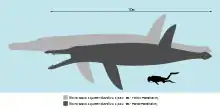
All Sauropterygians had a modified pectoral girdle that supported a powerful swimming stroke.[21] Kronosaurus and other plesiosaurs/pliosaurs had a similarly adapted pelvic girdle, allowing them to push hard against the water with all four flippers. Between its two limb girdles was a massive mesh of gastralia (belly ribs) that provided additional strength and support. The strength of the limb girdles, combined with evidence of large, powerful swimming muscles, indicates that Kronosaurus was likely a fast, active swimmer.[22]
K. queenslandicus has four pairs of premaxillary teeth. The first three pairs of its maxillary teeth are large caniniform teeth, and in its lower jaw there are also three pairs of large caniniform teeth which are located immediately in front of the three maxillary caniniforms when the mouth is closed. Two pairs of the lower jaw caniniforms occlude between the last pair of premaxillary teeth and first pair of maxillary teeth in a diastema (gap in the tooth row). The enlargement of these two pairs of lower jaw teeth in K. queenslandicus may be related to the absence of a fifth pair of premaxillary teeth, which are present in a number of other pliosaurs.[18]
Kronosaurus teeth exceed 7 centimeters (2.8 in) in length (the largest up to 30 centimeters (12 in) long with 12 centimeters (4.7 in) crowns). However, they lack carinae (cutting edges) and the distinct trihedral (three facets) of Pliosaurus and Liopleurodon teeth. The combination of large size, conical shape and lack of cutting edges allows for easy identification of Kronosaurus teeth in Cretaceous formations from Australia.[19][23]
Classification
Taxonomic validity
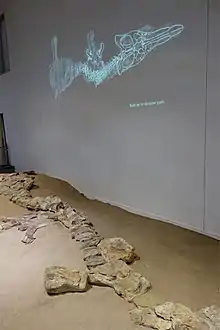
The validity of Kronosaurus was a longstanding issue due to the fragmentary nature of the holotype. Welles (1962) declared the taxon as a nomen vanum and recommended the designation of a neotype specimen that would preserve the taxon's validity.[24] McHenry (2009) subsequently proposed that two partial skeletons (QM F18827 and QM F10113) that matched the holotype's features and were from its same geological horizon (Toolebuc Formation) could be candidate neotypes.[18] However, no formal petition to the ICZN to designate a neotype was ever submitted. In 2021, Noè and Gómez-Pérez formally restricted Kronosaurus to the holotype and reidentified it as 'Pliosauridae (?Brauchauchiniinae) indet.', essentially reducing the taxon to a nomen dubium. They subsequently erected a new taxon named Eiectus longmani with the Harvard skeleton (MCZ 1285) as its holotype and reassigned all specimens previously referred as K. queenslandicus to it.[25] This move, which was interpreted as renaming the entire species to E. longmani, faced criticism by paleontologists. Darren Naish commented that the apparent renaming was "not a good idea"[26] that discourages stability[27] while paleontologist Daniel Madzia dubbed the situation "Kronogate"[28] and criticized the decision to not petition for a neotype.[29]
However, the reassignment of all Kronosaurus material to the new taxon is tentative. Noè & Gómez-Pérez (2021) noted the likelihood that the fossils actually represent multiple pliosaur species, meaning that the Toolebuc Formation specimens could be distinct from E. longmani,[25] and previous studies already suggested that the Harvard skeleton might be distinct from K. queenslandicus.[18] Nevertheless, Fischer et al. (2023) criticized the reassignments even under these circumstances, predicting that they stand contrary to ICZN Articles 75.5 and 75.6 (which codifies preference for neotype designation for previously iconic taxa with non-diagnostic holotypes) and that the aforementioned multiple-species possibility cannot justify a tentative reassignment of all specimens to Eiectus. The authors instead opted to refer to all relevant fossils as Kronosaurus-Eiectus.[30] Poropat et al. (2023) also criticized the reassignment of Toolebuc specimens on the grounds that it ignores McHenry (2009)'s conclusion that only one pliosaur species exists in the formation and therefore all of its specimens can reliably be assumed as conspecific with the holotype. The 2023 study maintained K. queenslandicus as a nominally valid taxon that includes all Toolebuc and Allaru Formation fossils pending a formal ICZN petition, recommending QM F18827 (the most complete known skull) as the neotype. They also criticized Noè & Gómez-Pérez (2021)'s designation of MCZ 1285 as the holotype of E. longmani without a formal redescription, as the skeleton is so heavily restored with plaster that any apparent diagnostic features are probably unreliable without full CT scans.[1]
Classification
Traditionally, Kronosaurus is classified as a member of the subfamily Brachaucheninae, which consists of pliosaurs that are currently only known during the Cretaceous period. Phylogenetic analyzes consider it close to certain genera such as Brachauchenius or Megacephalosaurus, particularly on the basis of dental comparisons.[31]
The cladogram below is modified from Madzia et al. (2018).[31]
| Thalassophonea |
| ||||||||||||||||||||||||||||||||||||||||||||||||||||||||||||||||||||||||||||||||||||||||||||||||||||||||||||||||||||||||
Palaeobiology
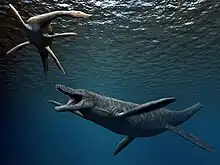
Fossil stomach contents from Northern Queensland show that Kronosaurus preyed on turtles and plesiosaurs. Fossil remains of large octobrachians[32] have been found in the same area as Kronosaurus. While no direct evidence of the animal predating on these octobrachians exists they fall within the projected size range of prey Kronosaurus would potentially have pursued.[18]
Large, round bite-marks have been found on the skull of an Albian-age Australian elasmosaurid (Eromangasaurus) that could be from a Kronosaurus attack.[33][34]
Paleoecology
Kronosaurus is known from remains in Australia. The area was covered by a shallow inland sea called the Eromanga Sea which Kronosaurus inhabited.[35] This environment was notably cold, experiencing near freezing temperatures[36] and seasonal ice in certain regions.[18][37]
See also
References
- 1 2 Stephen F. Poropat; Phil R. Bell; Lachlan J. Hart; Steven W. Salisbury; Benjamin P. Kear (2023). "An annotated checklist of Australian Mesozoic tetrapods". Alcheringa: An Australasian Journal of Palaeontology. 47 (2): 129–205. doi:10.1080/03115518.2023.2228367.
- ↑ Albert H. Longman (1924). "A new gigantic marine reptile from the Queensland Cretaceous, Kronosaurus queenslandicus new genus and species". Memoirs of the Queensland Museum. 8: 26–28.
- ↑ Ben Creisler (2012). "Ben Creisler's Plesiosaur Pronunciation Guide". Oceans of Kansas. Retrieved 26 June 2021.
- 1 2 3 4 Patricia Mather (1986). "The Longman Era". A time for a museum : the history of the Queensland Museum 1862-1986. Vol. 24. South Brisbane, Queensland: Queensland Museum. pp. 138–141. ISBN 978-0-724-21645-1.
- 1 2 J. Stanley Gardiner (1931). "The Harvard Museum Expedition to Australia". Nature. 128 (3228): 457–458. Bibcode:1931Natur.128..457G. doi:10.1038/128457c0. S2CID 29715877.
- 1 2 John L. Capinera (2008). "Darlington, Jr., Philip J". Encyclopedia of Entomologists. Dordrecht: Springer. pp. 1153–1154. ISBN 978-1-402-06242-1.
- ↑ George Hangay; Roger De Keyzer (2017). A Guide to Stag Beetles of Australia. Clayton, South Australia: CSIRO publishing. p. 139. ISBN 978-1-486-30208-6.
- 1 2 3 4 5 E. H. Hall; M. Hall (1964). About the Exhibits. Cambridge: Museum of Comparative Zoology. p. 50.
- ↑ W. E. Schevill (1932), "Appendix report on the second part of the Harvard australian expedition 1931-1932", in Harvard University (ed.), Annual report of the director of the Museum of Comparative Zoology at Harvard College, to the president of Harvard College for 1932–1933, Cambridge, pp. 54–58, OCLC 891553343
{{citation}}: CS1 maint: location missing publisher (link) - ↑ "News-Press from Fort Myers, Florida · Page 9". The News-Press. 26 January 1989.
- ↑ J. Bailey (2005). R. W. H. Thomas : a man of distinction. Kangaloon, N.S.W. p. 116. ISBN 978-0-958-54806-9.
{{cite book}}: CS1 maint: location missing publisher (link) - 1 2 3 Troy Meyers (2005). "Kronosaurus Chronicles". Australian Age of Dinosaurs (3). OCLC 7128427099.
- ↑ M. E. Miller (25 April 1956). "Zoology Museum to Exhibit Largest Sea-Reptile Fossil". The Harvard Crimson.
- ↑ W. D. Ian Rolfe (2012). "William Edward SCHEVILL: palaeontologist, librarian, cetacean biologist". Archives of Natural History. 39 (1): 162–164. doi:10.3366/ANH.2012.0069. S2CID 84278414.
- ↑ "1930s: The One That Got Away". Australian Museum. 19 July 2017.
- 1 2 3 Nancy Pick; Mark Sloan (2004). The rarest of the rare : stories behind the treasures at the Harvard Museum of Natural History. New York: HarperResource. p. 178. ISBN 978-0-060-53718-0.
- ↑ Alfred S. Romer; Arnold D. Lewis (1959). "A mounted skeleton of the giant plesiosaur Kronosaurus". Breviora (112): 1–15. S2CID 83514457.
- 1 2 3 4 5 6 7 8 9 Colin R. McHenry (2009). Devourer of Gods: The palaeoecology of the Cretaceous pliosaur Kronosaurus queenslandicus (Thesis). The University of Newcastle. hdl:1959.13/935911. S2CID 132852950.
- 1 2 Benjamin P. Kear (2003). "Cretaceous marine reptiles of Australia: a review of taxonomy and distribution" (PDF). Cretaceous Research. 24 (3): 277–303. Bibcode:2003CrRes..24..277K. doi:10.1016/S0195-6671(03)00046-6. S2CID 128619215.
- ↑ Roger B. J. Benson; Mark Evans; Adam S. Smith; Judyth Sassoon; Scott Moore-Faye; Hilary F. Ketchum; Richard Forrest (2013). "A Giant Pliosaurid Skull from the Late Jurassic of England". PLOS ONE. 8 (5): e65989. Bibcode:2013PLoSO...865989B. doi:10.1371/journal.pone.0065989. PMC 3669260. PMID 23741520.
- ↑ "Sauropterygia". Palaeos. Archived from the original on 4 January 2022.
- ↑ "Sauropterygia: More on Plesiosauria". Palaeos. Archived from the original on 5 September 2021.
- ↑ J. A. Massare (1997). "Introduction – faunas, behaviour and evolution". Ancient Marine Reptiles. Academic Press. pp. 401–421. ISBN 978-0-12-155210-7.
- ↑ Samuel P. Welles (1962). "A new species of elasmosaur from the Aptian of Colombia and a review of the Cretaceous plesiosaurs" (PDF). University of California Publications in Geological Sciences. 44 (1): 1–96. OCLC 5734397. Archived from the original (PDF) on 4 January 2022.
- 1 2 Leslie F. Noè; M. Gómez-Pérez (2021). "Giant pliosaurids (Sauropterygia; Plesiosauria) from the Lower Cretaceous peri-Gondwanan seas of Colombia and Australia". Cretaceous Research. 132: 105122. doi:10.1016/j.cretres.2021.105122.
- ↑ Darren Naish [@TetZoo] (20 December 2021). "It's happened. Kronosaurus made a nomen dubium, the referred diagnostic stuff now the new taxon Eiectus longmani Noè & Gómez-Pérez, 2021. Immediate instincts are that this is not a good idea" (Tweet) – via Twitter.
- ↑ Darren Naish [@TetZoo] (20 December 2021). "It looks like the opposite of a decision that promotes stability, since every statement ever made about Kronosaurus now refers to Eiectus" (Tweet) – via Twitter.
- ↑ Daniel Madiza [@danielmadzia] (7 April 2022). "This means that if we want to keep the name Liopleurodon in use (and especially avoid another 'Kronogate'), L. ferox is in need of a detailed reevaluation and an ICZN petition should probably be filed to request that its type is replaced with something diagnostic;" (Tweet) – via Twitter.
- ↑ Daniel Madzia [@danielmadzia] (20 December 2021). "Haven't read the paper yet so the authors may discuss this option but petition to ICZN to replace the type seems *much* more appropriate than offering new name for the Kronosaurus material" (Tweet) – via Twitter.
- ↑ Valentin Fischer; Roger B. J. Benson; Nikolay G. Zverkov; Maxim S. Arkhangelsky; Ilya M. Stenshin; Gleb N. Uspensky; Natalya E. Prilepskaya (2023). "Anatomy and relationships of the bizarre Early Cretaceous pliosaurid Luskhan itilensis". Zoological Journal of the Linnean Society. 198 (1): 220–256. doi:10.1093/zoolinnean/zlac108. S2CID 257573659.
- 1 2 Daniel Madzia; Sven Sachs; Johan Lindgren (2018). "Morphological and phylogenetic aspects of the dentition of Megacephalosaurus eulerti, a pliosaurid from the Turonian of Kansas, USA, with remarks on the cranial anatomy of the taxon". Geological Magazine. 156 (7): 1–16. Bibcode:2019GeoM..156.1201M. doi:10.1017/S0016756818000523. S2CID 133859507.
- ↑ Dirk Fuchs (2019). "Eromangateuthis n. gen., a new genus for a late Albian gladius-bearing giant octobrachian (Cephalopoda: Coleoidea)". Paleontological Contributions. 2019 (21): 4. doi:10.17161/1808.29619. hdl:1808/29619. S2CID 204976334.
- ↑ Sven Sachs (2005). "Tuarangisaurus australis sp. nov. (Plesiosauria: Elasmosauridae) from the Lower Cretaceous of northeastern Queensland, with additional notes on the phylogeny of the Elasmosauridae". Memoirs of the Queensland Museum. 50 (2): 425–440.
- ↑ Benjamin P. Kear (2007). "Taxonomic clarification of the Australian elasmosaurid genus Eromangasaurus, with reference to other austral elasmosaur taxa". Journal of Vertebrate Paleontology. 27 (1): 241–246. doi:10.1671/0272-4634(2007)27[241:TCOTAE]2.0.CO;2. JSTOR 4524684. S2CID 86673814.
- ↑ "Kronosaurus queenslandicus". Queensland Museum. Archived from the original on 29 October 2022.
- ↑ Jennifer L. De Lurio; L.A. Frakes (1999). "Glendonites as a paleoenvironmental tool: implications for early Cretaceous high latitude climates in Australia". Geochimica et Cosmochimica Acta. 63 (7–8): 1039–1048. doi:10.1016/S0016-7037(99)00019-8. S2CID 129214840.
- ↑ N. F. Alley; S. B. Hore; L. A. Frakes (2019). "Glaciations at high-latitude Southern Australia during the Early Cretaceous". Australian Journal of Earth Sciences. 67 (8): 1045–1095. doi:10.1080/08120099.2019.1590457. S2CID 155844277.
External links
- Genus Kronosaurus. The Plesiosaur Directory.
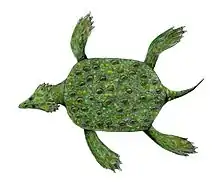
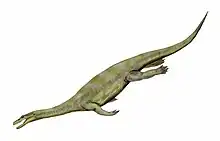
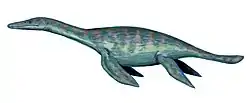

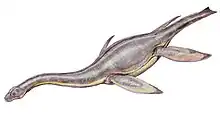

.png.webp)